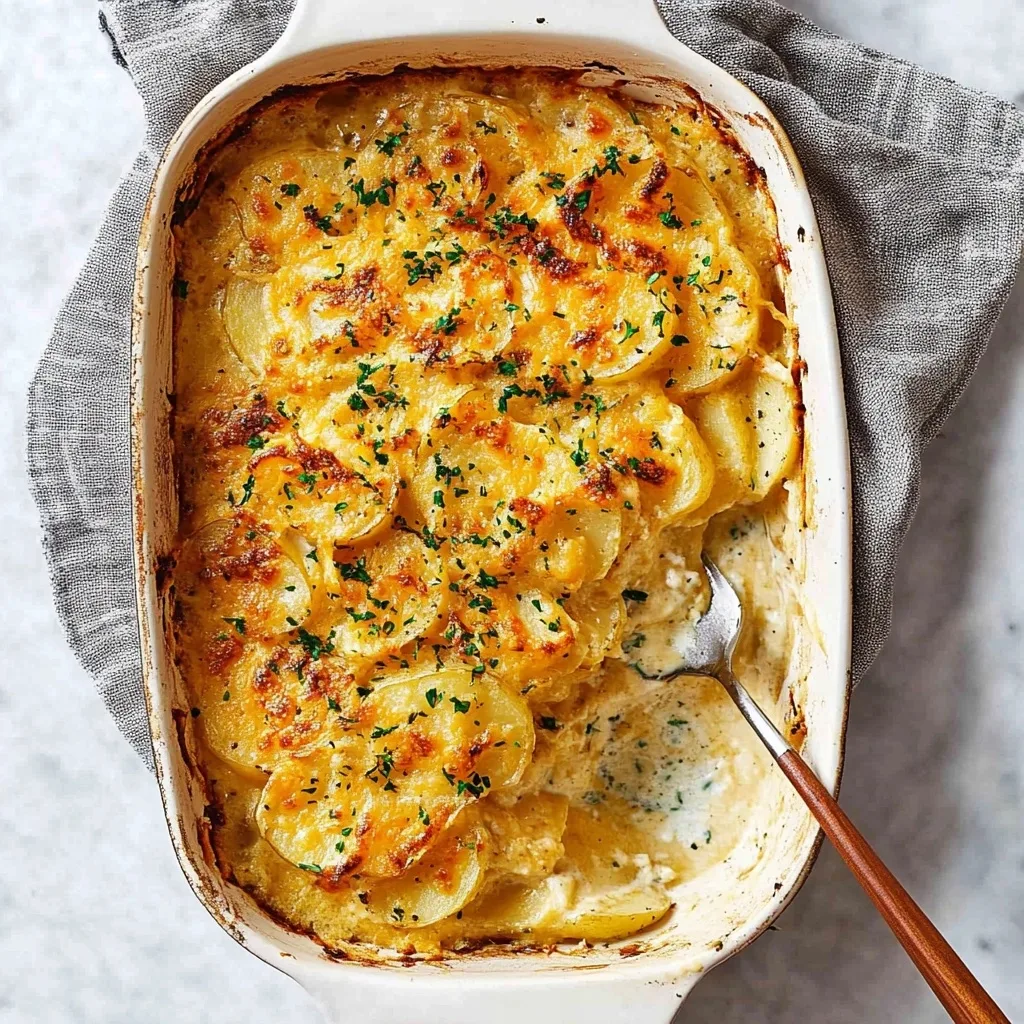There’s something magical about a dish of perfectly prepared scalloped potatoes. That moment when your fork breaks through the golden, bubbling cheese crust and sinks into layers of tender potato slices bathed in creamy sauce. This classic comfort food has graced holiday tables and Sunday dinners for generations, and for good reason. These scalloped potatoes balance simplicity and indulgence in a way few other dishes can achieve.
Whether you’re serving them alongside a holiday roast or as a hearty main dish with a simple salad, this scalloped potatoes recipe delivers restaurant-quality results with straightforward ingredients and techniques. The combination of thinly sliced russet potatoes, sharp cheddar, Parmesan, and a velvety sauce creates a dish that’s greater than the sum of its parts.
In this article, we’ll walk through creating perfectly creamy scalloped potatoes with a golden cheese crust, explore the history behind this beloved dish, share expert tips for success, and answer common questions. Let’s transform humble potatoes into something extraordinary!
The Rich History of Scalloped Potatoes
Scalloped potatoes have a long and delicious history dating back centuries. The term “scalloped” actually refers to the traditional serving dish used – a scallop-shaped baking dish with fluted edges. This preparation method of thinly slicing potatoes and baking them in a creamy sauce gained popularity throughout Europe before making its way to America.
While many confuse scalloped potatoes with potatoes au gratin (which traditionally contains cheese), modern recipes for scalloped potatoes, including ours, have embraced cheese as an essential ingredient. This evolution has created the best of both worlds: the classic creamy texture of traditional scalloped potatoes with the irresistible flavor and golden top that comes from quality cheese.
What makes scalloped potatoes so enduring is their perfect balance of simplicity and richness. They transform basic ingredients into something truly special through careful preparation and patience. The dish also offers endless adaptability, working as both a supporting side and a satisfying main course depending on how it’s served.
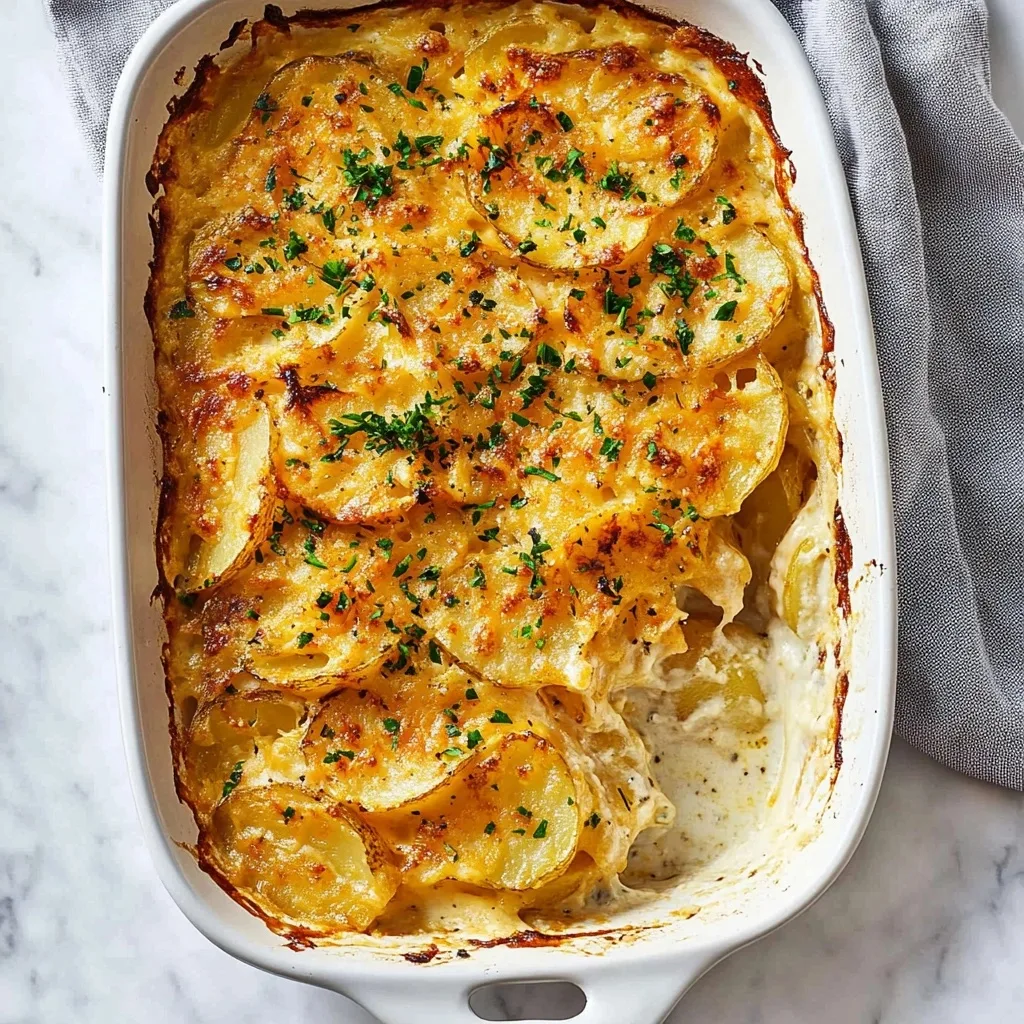
Key Ingredients for Perfect Scalloped Potatoes
Choosing the Right Potatoes
The foundation of exceptional scalloped potatoes begins with selecting the correct potato variety. Russet potatoes are the gold standard for this dish for several compelling reasons. Their high starch content helps thicken the sauce while their relatively low moisture prevents the dish from becoming watery. They also hold their shape beautifully during the long baking time while still becoming perfectly tender.
When selecting russets, look for firm potatoes with no green spots, sprouts, or soft areas. Medium to large potatoes work best as they’re easier to slice uniformly. For this recipe, you’ll need about 6-7 medium russets to yield the 2 pounds called for.
The Creamy Sauce Foundation
The sauce in scalloped potatoes isn’t just a supporting player—it’s the binding element that transforms individual potato slices into a cohesive, luxurious dish. Our sauce begins with a classic roux made from butter and flour, which provides the perfect thickening base.
The combination of whole milk and heavy cream creates the ideal richness. While you could use all milk, the addition of heavy cream significantly improves both flavor and texture. Warming the dairy slightly before adding it to the roux helps prevent lumps and allows for faster thickening.
The garlic, salt, pepper, onion powder, and optional paprika may seem simple, but they create a perfectly balanced flavor profile that complements the potatoes without overwhelming them. The paprika adds not only a subtle warmth but also contributes to the beautiful golden color of the finished dish.
Cheese Selection Matters
The cheese in scalloped potatoes serves dual purposes: it enriches the cream sauce and creates that irresistible golden top that signals perfection. Our recipe calls for sharp cheddar, which provides excellent flavor and melting properties, complemented by Parmesan for its distinctive salty notes and browning capabilities.
Sharp cheddar is preferred over mild varieties because it stands up better to the cream sauce and long baking time. When possible, grate your own cheese rather than using pre-shredded varieties, which often contain anti-caking agents that can affect how the cheese melts.
Mastering the Technique
Creating the Perfect Sauce
The sauce for scalloped potatoes begins with a roux—equal parts fat and flour cooked together to form a thickening base. This crucial step requires attention to detail for perfect results.
Begin by melting butter over medium heat. Once melted but not browned, add the flour and whisk constantly. This mixture needs to cook for about a minute to eliminate the raw flour taste. The texture should resemble wet sand, and the color should remain blonde rather than brown (unlike a dark roux used for gumbo or other dishes).
When adding the warm milk and cream, pour slowly while whisking constantly to prevent lumps from forming. This gradual incorporation is crucial for a silky-smooth sauce. The sauce will initially thin out when you add the liquid, but continue whisking and cooking for about 5 minutes until it visibly thickens and coats the back of a spoon.
Adding a portion of the cheese directly to the sauce infuses it with flavor and creates a more cohesive final dish. Be sure to remove the saucepan from heat before adding this cheese to prevent the proteins from seizing and creating a grainy texture.
The Art of Potato Slicing
Uniform potato slices are non-negotiable for perfect scalloped potatoes. The ideal thickness is approximately 1/8-inch—thin enough to cook through properly but thick enough to maintain structure.
A mandoline slicer is the best tool for achieving consistent slices, but a sharp chef’s knife works well with a steady hand and patience. If using a knife, try to maintain a consistent rhythm and thickness as you work through the potatoes.
After slicing, rinse the potatoes briefly under cold water to remove some surface starch, then pat them dry before assembling. This prevents the sauce from becoming gluey during baking.
Perfecting the Layering Process
Layering scalloped potatoes might seem straightforward, but strategic assembly makes a significant difference in the final result. Begin with a thin layer of sauce on the bottom of the baking dish to prevent sticking, then add half the potato slices.
Rather than piling the potatoes randomly, try to slightly overlap them in rows. This creates more even cooking and better sauce distribution. Pour half the sauce evenly over this layer, ensuring it flows between the potato slices, then sprinkle with a portion of both cheeses.
Repeat with remaining potatoes, more sauce, and finish with a generous cheese topping. This final cheese layer is your ticket to that magazine-worthy golden crust, so don’t be shy here!
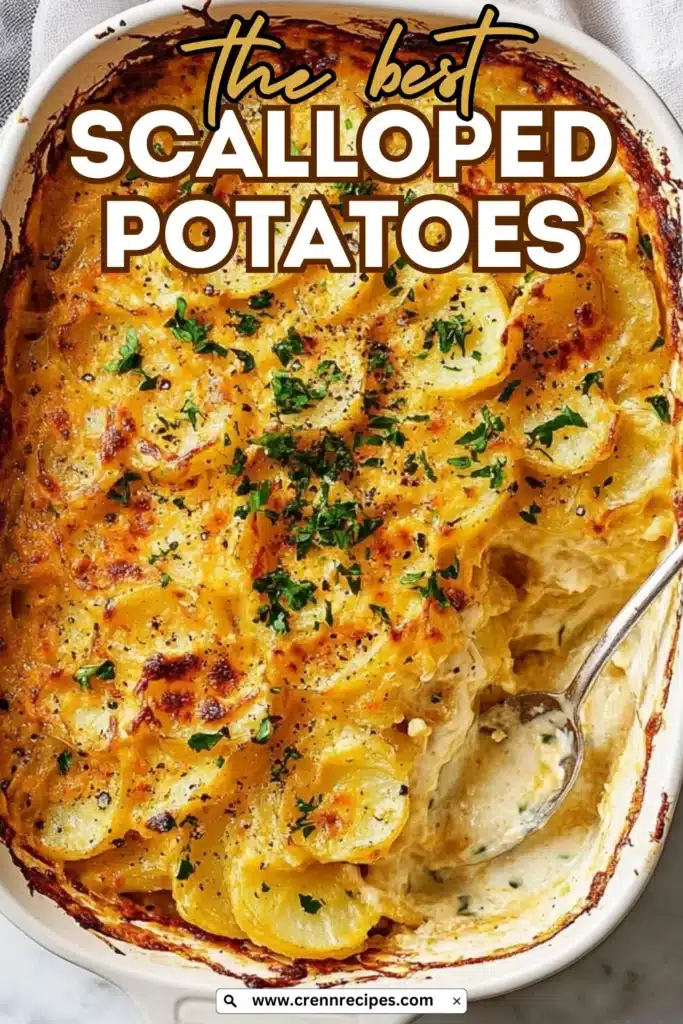
Complete Scalloped Potatoes Recipe
Ingredients
- 3 tablespoons unsalted butter
- 3 tablespoons all-purpose flour
- 2 cups whole milk, slightly warmed
- 1 cup heavy cream, slightly warmed
- 2 teaspoons garlic, minced
- 1½ teaspoons salt
- ½ teaspoon black pepper
- ½ teaspoon onion powder
- ½ teaspoon paprika (optional)
- 2 pounds russet potatoes, peeled and sliced thin (about 1/8-inch thick)
- 1½ cups shredded sharp cheddar cheese
- ½ cup grated Parmesan cheese
- Fresh parsley for garnish (optional)
Instructions
- Prepare the oven and baking dish: Preheat your oven to 375°F. Thoroughly grease a 9×13 inch baking dish with butter or cooking spray.
- Make the creamy sauce: In a medium saucepan over medium heat, melt the butter. Once melted, whisk in the flour and cook for about 1 minute, stirring constantly. This creates your roux, which will thicken the sauce. Slowly whisk in the warm milk and cream, adding in a steady stream while whisking continuously to prevent lumps. Continue cooking and stirring until the sauce thickens enough to coat the back of a spoon, about 5 minutes.
- Season and enhance the sauce: Stir in the minced garlic, salt, pepper, onion powder, and paprika. Add about ¼ cup of the cheddar and 2 tablespoons of the Parmesan cheese, stirring until melted and incorporated. Remove from heat.
- Begin layering: Arrange half of your sliced potatoes in the prepared baking dish, slightly overlapping them in even rows. Pour half of the sauce over the potatoes, ensuring even coverage. Sprinkle with about ⅓ of the remaining cheese.
- Complete the layers: Add the remaining potato slices in the same overlapping pattern. Pour the rest of the sauce evenly over the potatoes. Top with all remaining cheese, creating a complete coverage for that perfect golden crust.
- Bake to perfection: Place the baking dish on a larger baking sheet to catch any potential overflow. Bake uncovered in the preheated oven for 60-75 minutes. The dish is ready when the potatoes are fork-tender, the sauce is bubbling around the edges, and the top has turned a beautiful golden brown.
- Rest and serve: Allow the scalloped potatoes to rest for 10-15 minutes before serving. This crucial resting period allows the sauce to thicken and set properly. Garnish with freshly chopped parsley if desired before serving.
Pro Tips for Scalloped Potato Success
Getting the Right Consistency
The perfect scalloped potatoes should be creamy but not soupy, with tender potatoes that hold their shape. If your dish has turned out watery in the past, try these troubleshooting tips:
- Ensure you’re cooking the roux properly before adding liquid
- Allow the sauce to thicken adequately on the stovetop
- Pat the sliced potatoes dry before layering
- Let the finished dish rest for the full 15 minutes before serving
Conversely, if your scalloped potatoes tend to be too dry, check that you’re using enough sauce and that your oven isn’t running hot. Covering the dish with foil for the first 45 minutes of baking then removing it for the final 30 minutes can help maintain moisture while still achieving that desirable golden top.
Make-Ahead Options
Scalloped potatoes are an excellent candidate for make-ahead preparation, which is particularly helpful for holiday meals or entertaining. You have several options:
- Prepare the entire dish up to 24 hours ahead: Assemble completely, cover with plastic wrap, and refrigerate. Before baking, let it sit at room temperature for 30 minutes, then bake as directed, possibly adding an extra 10-15 minutes to the cooking time.
- Partially prepare components: Slice the potatoes and store them submerged in cold water in the refrigerator for up to 24 hours. Make the sauce up to 2 days ahead and refrigerate. When ready to bake, drain and dry the potatoes, rewarm the sauce slightly, and proceed with assembly.
- Fully bake and reheat: You can completely bake the dish a day ahead, refrigerate, and reheat covered at 350°F until hot throughout (about 30 minutes). This works especially well when you’re dealing with limited oven space for a multi-dish meal.
Flavor Variations and Additions
While this classic recipe is perfect as written, scalloped potatoes welcome creative variations:
- Herb-infused: Add fresh thyme, rosemary, or sage to the sauce
- Onion lovers: Layer thin slices of yellow or sweet onion between the potato layers
- Protein additions: Include diced ham, crispy bacon, or shredded rotisserie chicken between layers
- Extra decadent: Fold in 2-3 ounces of cream cheese to the sauce for ultimate richness
- Different cheese profiles: Substitute Gruyère, Fontina, or smoked Gouda for some or all of the cheddar
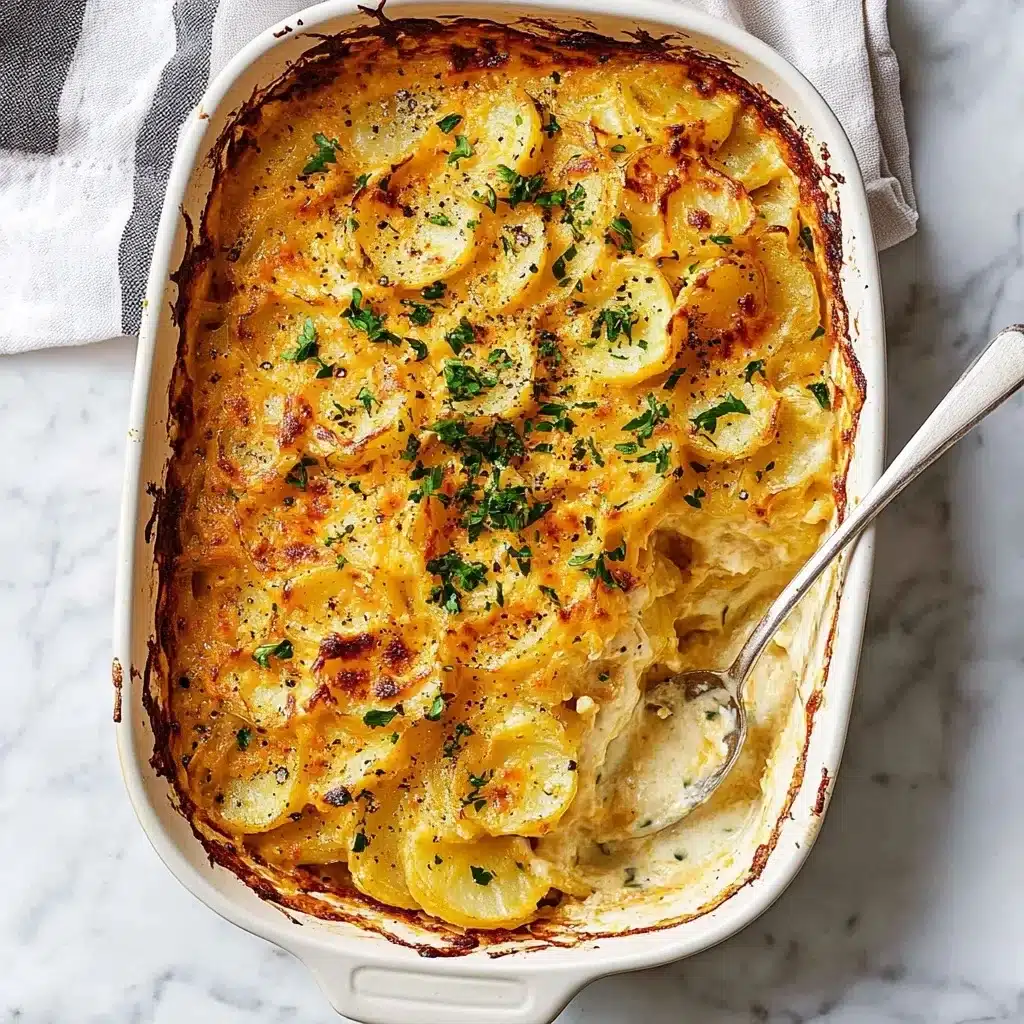
Serving and Pairing Suggestions
Creating a Complete Meal
Scalloped potatoes pair beautifully with a variety of main dishes and sides. For a classic holiday meal, serve alongside:
- Glazed ham or roast beef
- Roasted Brussels sprouts or green beans
- A simple green salad with vinaigrette
For a weeknight family dinner, these potatoes can be the star with:
- A rotisserie chicken
- Steamed broccoli or roasted carrots
- Crusty bread for sauce-sopping
You can even transform scalloped potatoes into a hearty main dish by adding protein directly to the layers or serving with a fried egg on top for a delicious breakfast-for-dinner option.
Storage and Reheating Tips
Properly stored, leftover scalloped potatoes will keep in the refrigerator for 3-4 days. Cover the dish with plastic wrap or transfer portions to airtight containers.
For best reheating results:
- Oven method: Cover with foil and heat at 350°F for 20-30 minutes until warmed through. Remove foil for the last 5 minutes to re-crisp the top.
- Microwave method: For individual portions, microwave on 70% power for 2-3 minutes, checking halfway through. The reduced power helps prevent the sauce from separating.
- Skillet revival: For a delicious twist, chop cold scalloped potatoes into chunks and fry in a buttered skillet until crispy on the outside and hot within.
Frequently Asked Questions
Why are my scalloped potatoes still hard after cooking?
If your potatoes remain firm after the full cooking time, several factors might be at play. The most common culprit is potato slices that are too thick—aim for that consistent 1/8-inch thickness. Another possibility is that your oven temperature may be inaccurate, running cooler than the setting indicates. Using an oven thermometer can help verify the actual temperature.
Lastly, the type of potato matters significantly. Waxy potatoes like Yukon Golds take longer to soften than russets. If your potatoes need more time, simply continue baking, checking every 10-15 minutes, and cover with foil if the top is browning too quickly.
How do I prevent my sauce from curdling?
Curdling occurs when the proteins in dairy separate from the liquids due to high heat or acidity. To prevent this in your scalloped potatoes:
- Warm the milk and cream slightly before adding to the roux
- Use fresh dairy products with higher fat content (whole milk, not skim)
- Cook the sauce over medium heat, never high heat
- Add cheese off the heat or at very low temperatures
- Ensure the sauce is properly thickened with the roux before assembling
Can I make scalloped potatoes without dairy?
Yes! While traditional scalloped potatoes rely on dairy for their characteristic creaminess, you can create excellent dairy-free versions using these substitutions:
- Replace butter with olive oil or a plant-based butter alternative
- Substitute the milk and cream with unsweetened, plain plant-based alternatives (oat milk and coconut cream work particularly well)
- Use dairy-free cheese alternatives designed for melting
- Add a tablespoon of nutritional yeast to the sauce for cheesy flavor
- Consider adding a touch more seasoning, as dairy-free versions may need flavor enhancement
What’s the difference between scalloped potatoes and au gratin potatoes?
Traditionally, the distinction was clear: scalloped potatoes featured a cream sauce without cheese, while potatoes au gratin included cheese in the dish and often breadcrumbs on top. However, modern recipes have blurred these lines considerably.
Today, most people consider scalloped potatoes to have a cream sauce that may include cheese, while au gratin potatoes definitively include cheese both in the sauce and as a significant topping, often with a breadcrumb mixture. Our recipe combines the best elements of both traditions for an optimal result.
Why These Scalloped Potatoes Will Become Your Signature Dish
These scalloped potatoes strike the perfect balance between impressive and accessible. The straightforward technique yields professional-quality results that will have family and guests raving. The dish works equally well for special occasions and Sunday family dinners, versatile enough to complement almost any meal.
What makes this recipe special is the attention to detail—the carefully crafted sauce, the perfect potato slices, and the strategic layering. These elements combine to create scalloped potatoes that aren’t just good; they’re memorable.
Whether you’re making them for the first time or the fiftieth, these scalloped potatoes deliver consistency and comfort in every bite. The recipe has been refined to eliminate common pitfalls while maximizing flavor and texture. Master this dish, and you’ll always have a crowd-pleasing option in your culinary arsenal.
More Related Recipes You Might Enjoy
If you enjoyed these scalloped potatoes, here are some other delicious recipes featuring potatoes or complementary dishes that would pair beautifully with this classic comfort food:
- Thanksgiving Lentil and Potato Soup – Another hearty potato dish with rich flavors, perfect for cooler weather alongside your scalloped potatoes
- How to Roast Brussels Sprouts – The perfect green vegetable side dish to balance the creamy richness of scalloped potatoes
- Autumn Harvest Grain Bowl – A nutritious, seasonal dish that complements the comfort food appeal of scalloped potatoes for a complete meal
Next time you’re craving the ultimate comfort food, look no further than these perfectly creamy, cheesy scalloped potatoes. With their golden top, velvety sauce, and tender potato layers, they’re sure to become a requested favorite at your table for years to come!
Print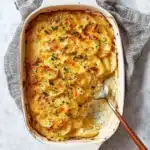
Scalloped Potatoes: Amazing Cheesy Comfort Food in 10 Steps
- Total Time: 1 hour 35 minutes
- Yield: 8 servings 1x
Description
Creamy, cheesy scalloped potatoes featuring thinly sliced russet potatoes layered with a velvety sauce made from scratch. This classic comfort food dish boasts a perfectly golden, bubbly cheese crust and tender potato layers that make it an ideal side for holidays, Sunday dinners, or any special meal. The combination of sharp cheddar and Parmesan cheeses creates an irresistible flavor profile that will have everyone asking for seconds.
Ingredients
- 3 tablespoons unsalted butter
- 3 tablespoons all-purpose flour
- 2 cups whole milk, slightly warmed
- 1 cup heavy cream, slightly warmed
- 2 teaspoons garlic, minced
- 1½ teaspoons salt
- ½ teaspoon black pepper
- ½ teaspoon onion powder
- ½ teaspoon paprika (optional)
- 2 pounds russet potatoes, peeled and sliced thin (about 1/8-inch thick)
- 1½ cups shredded sharp cheddar cheese
- ½ cup grated Parmesan cheese
- Fresh parsley for garnish (optional)
Instructions
- Preheat your oven to 375°F. Thoroughly grease a 9×13 inch baking dish with butter or cooking spray.
- In a medium saucepan over medium heat, melt the butter. Once melted, whisk in the flour and cook for about 1 minute, stirring constantly. This creates your roux, which will thicken the sauce.
- Slowly whisk in the warm milk and cream, adding in a steady stream while whisking continuously to prevent lumps. Continue cooking and stirring until the sauce thickens enough to coat the back of a spoon, about 5 minutes.
- Stir in the minced garlic, salt, pepper, onion powder, and paprika. Add about ¼ cup of the cheddar and 2 tablespoons of the Parmesan cheese, stirring until melted and incorporated. Remove from heat.
- Arrange half of your sliced potatoes in the prepared baking dish, slightly overlapping them in even rows. Pour half of the sauce over the potatoes, ensuring even coverage. Sprinkle with about ⅓ of the remaining cheese.
- Add the remaining potato slices in the same overlapping pattern. Pour the rest of the sauce evenly over the potatoes. Top with all remaining cheese, creating a complete coverage for that perfect golden crust.
- Place the baking dish on a larger baking sheet to catch any potential overflow. Bake uncovered in the preheated oven for 60-75 minutes. The dish is ready when the potatoes are fork-tender, the sauce is bubbling around the edges, and the top has turned a beautiful golden brown.
- Allow the scalloped potatoes to rest for 10-15 minutes before serving. This crucial resting period allows the sauce to thicken and set properly. Garnish with freshly chopped parsley if desired before serving.
Notes
- For best results, slice potatoes to a consistent thickness (about 1/8 inch). A mandoline slicer works perfectly for this.
- Warming the milk and cream before adding to the roux helps prevent lumps and allows for faster thickening.
- To make ahead: Assemble the dish up to 24 hours in advance, cover, and refrigerate. Let stand at room temperature for 30 minutes before baking.
- For freezing: Fully assemble but do not bake. Cover tightly and freeze for up to 3 months. Thaw overnight in the refrigerator before baking.
- Variation ideas: Add layers of thinly sliced onion, fold in diced ham or bacon, or try different cheese combinations such as Gruyère or smoked Gouda.
- Prep Time: 20 minutes
- Cook Time: 1 hour 15 minutes
- Category: Side Dish
- Method: Baking
- Cuisine: American
Nutrition
- Serving Size: 1/8 of recipe
- Calories: 325
- Sugar: 6g
- Sodium: 580mg
- Fat: 21g
- Saturated Fat: 13g
- Unsaturated Fat: 7g
- Trans Fat: 0g
- Carbohydrates: 25g
- Fiber: 2g
- Protein: 10g
- Cholesterol: 68mg

